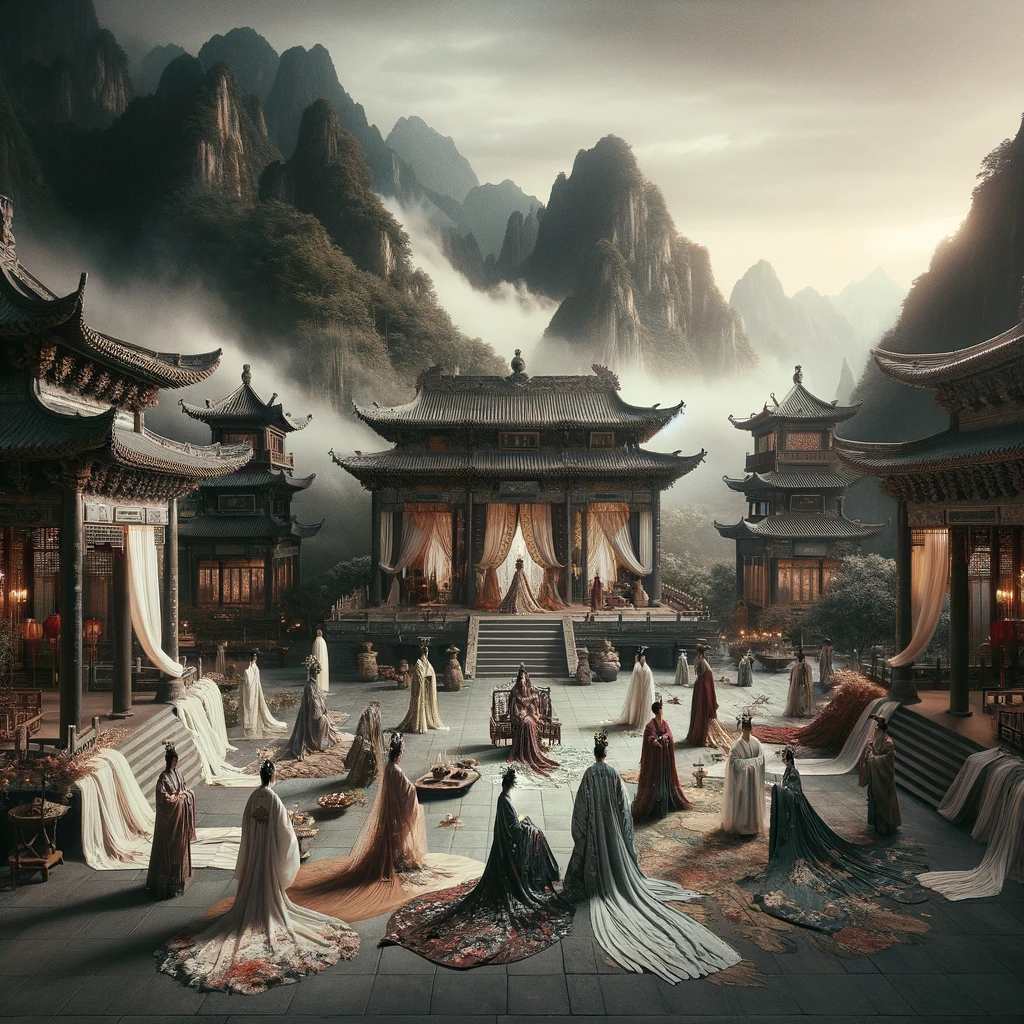Introduction
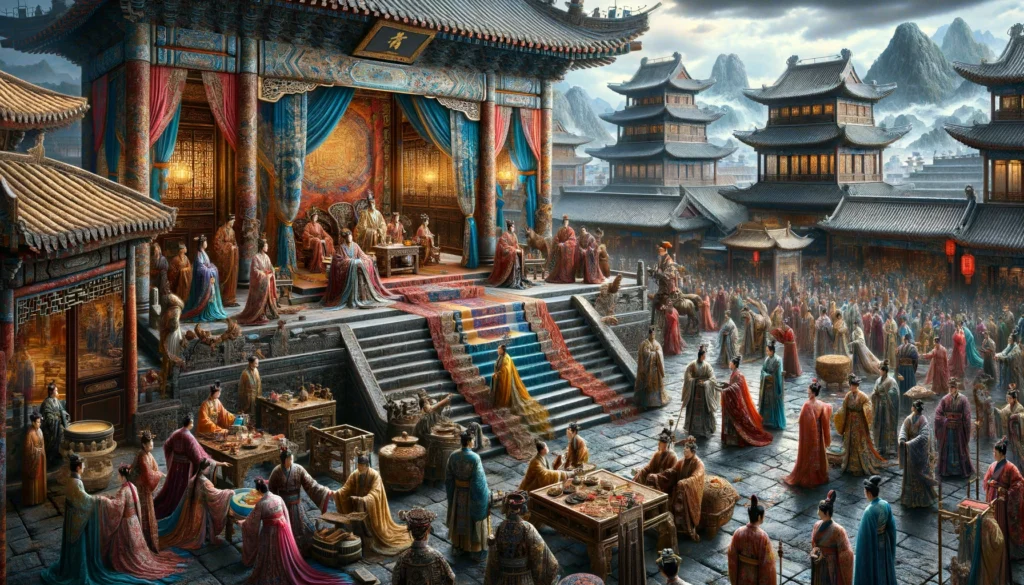
Dive into the opulent world of Chinese ancient fashion, a realm where every stitch and hue tells a story of centuries-old traditions, cultural evolutions, and the silent whispers of history’s movers and shakers. This journey through time showcases the magnificent diversity of clothing styles that flourished across different dynasties, reflecting not just aesthetic preferences but the social, political, and philosophical undercurrents of their eras. From the sumptuous silks of the Han Dynasty to the intricate embroideries of the Ming Dynasty, each period brought its own contributions to what would become a rich tapestry of Chinese cultural heritage. Influential figures, from emperors and empresses to artisans and philosophers, played pivotal roles in shaping the fashion landscape, leaving behind a legacy that continues to inspire and awe. As we unravel the layers of Chinese ancient fashion, we reveal more than just clothing; we discover a civilization’s enduring spirit and innovative prowess, mirrored in the elegance of its attire.
Key Takeaways
Delving into the rich tapestry of Chinese ancient fashion reveals not just a history of clothing but a deep, intertwined narrative of cultural identity, innovation, and global exchange. Here are the pivotal elements that underscore the enduring impact of Chinese ancient fashion on culture and society:
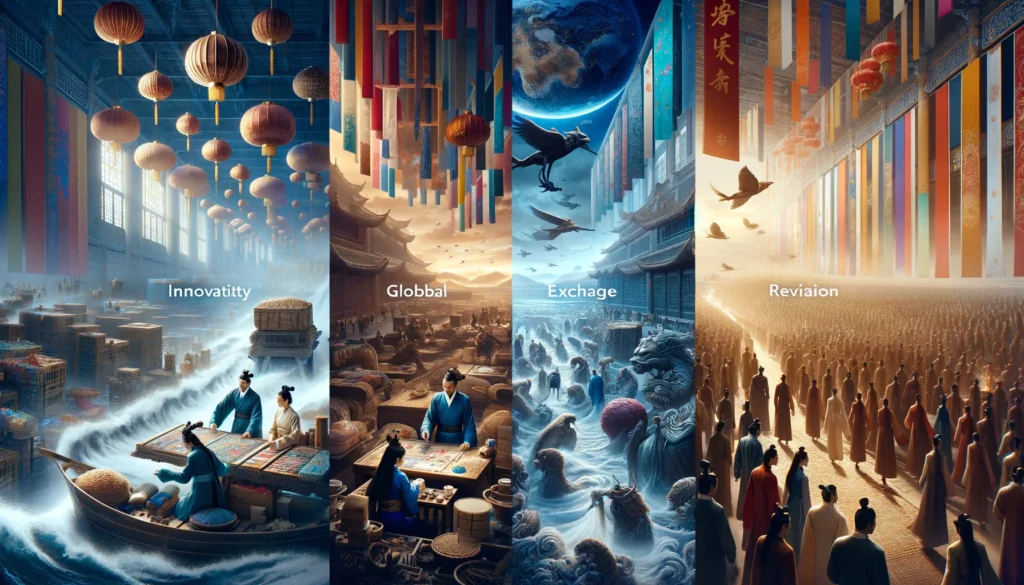
- Cultural Identity and Expression: Chinese ancient fashion serves as a vibrant expression of the nation’s cultural values, philosophies, and aesthetics. From the elegance of the Hanfu to the modernity of the Qipao, each style tells a story of its era, reflecting the societal norms, ethical beliefs, and artistic achievements of the time.
- Innovation and Craftsmanship: The artistry behind traditional Chinese textiles—ranging from silk weaving to intricate embroidery—demonstrates a legacy of innovation and craftsmanship. These techniques have not only contributed to the global textile industry but have also preserved a rich heritage of artisanal skills.
- Global Cultural Exchange: The influence of the Silk Road as a conduit for trade and cultural exchange underscores the global significance of Chinese fashion. The integration of foreign elements into Chinese clothing styles highlights the dynamic interactions between cultures and the mutual influences that have shaped global fashion trends.
- Revival and Modern Adaptations: The resurgence of interest in traditional Chinese clothing styles and their adaptation into contemporary fashion illustrate the enduring appeal and relevance of ancient fashion. This revival is a testament to the desire to reconnect with cultural roots while navigating a modern, globalized world.
- Societal and Philosophical Reflections: Ancient Chinese fashion reflects deeper societal structures and philosophical ideals, from the Confucian emphasis on hierarchy and decorum to Taoist principles of harmony with nature. Clothing was more than attire; it was a reflection of personal virtue and social order.
THE Dynasties
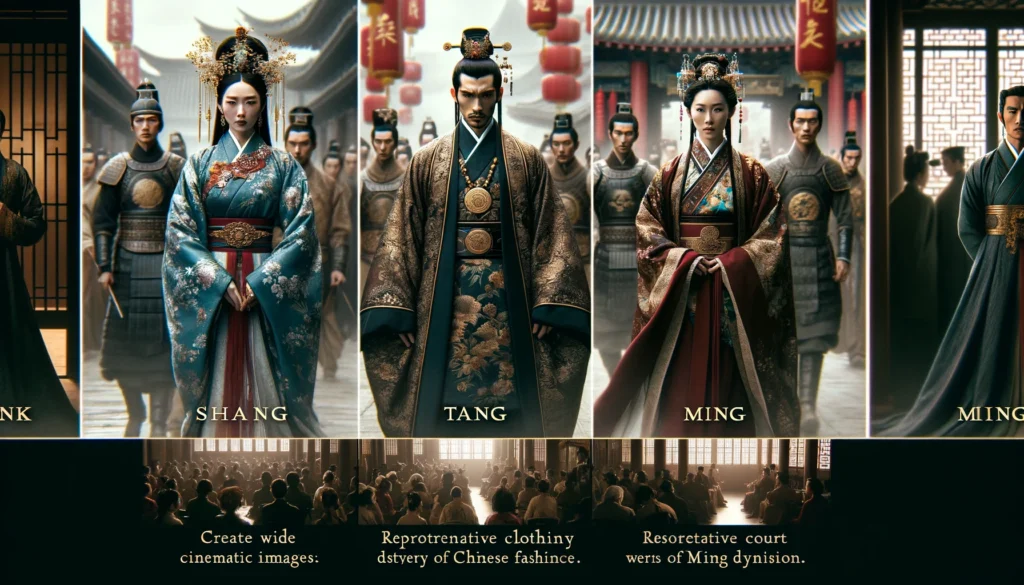
The tapestry of ancient Chinese fashion is interwoven with the rise and fall of its dynasties, each leaving an indelible mark on the fabric of history. Through the lens of fashion, we glimpse into the lives, cultures, and philosophies that shaped these eras.
Briefly describe the major Chinese dynasties and their impact on fashion.
- Shang Dynasty: Marked as the dawn of Chinese clothing arts, the Shang Dynasty laid the foundational stones for what would become a rich tradition of textile artistry. Utilizing bone, jade, and bronze, this era introduced ornamental beauty to functional wear, setting a precedent for centuries to come.
- Tang Dynasty: Celebrated as the golden age of prosperity and cultural diversity, the Tang Dynasty saw the fusion of Chinese clothing with foreign influences, leading to vibrant styles characterized by wide sleeves, flowing robes, and the iconic ruqun. This period epitomized inclusivity and innovation in fashion.
- Ming Dynasty: A time for the refinement of traditional Chinese clothing styles, the Ming Dynasty is renowned for its development of the Hanfu, with stricter dress codes that emphasized elegance and simplicity. The silhouette became more structured, with distinct distinctions between social classes and occupations.
Highlight the most significant changes in clothing styles during each dynasty.
- Evolution of silhouettes, fabrics, and decorative techniques: From the loosely fitted garments of the Shang Dynasty to the ornate, structured elegance of the Ming Dynasty, clothing styles evolved to reflect the changing tastes, technologies, and materials available. Silk became increasingly prominent, along with advancements in dyeing and embroidery that allowed for more intricate designs.
- The impact of political and economic changes on fashion: Each dynasty’s political climate and interactions with neighboring regions influenced its fashion. The Tang Dynasty’s openness to the Silk Road introduced new materials and styles, while the Ming Dynasty’s stability allowed for the flourishing of arts, including fashion.
Include visuals of representative clothing styles from each dynasty.
- Shang Dynasty: Illustrations of jade ornaments and bronze ware alongside robes depict the early sophistication of Chinese dress.
- Tang Dynasty: Artistic renditions highlight the cosmopolitan flair of Tang attire, with vibrant colors and flowing silhouettes that reflect its cultural diversity.
- Ming Dynasty: Photographs of preserved garments and paintings reveal the refined elegance of Ming fashion, showcasing the sophistication of its embroidery and the richness of its fabrics.
Through these visual and descriptive explorations, we see not just the evolution of clothing but the story of a civilization that dressed not merely for necessity but as an expression of its collective soul.
Clothing Styles
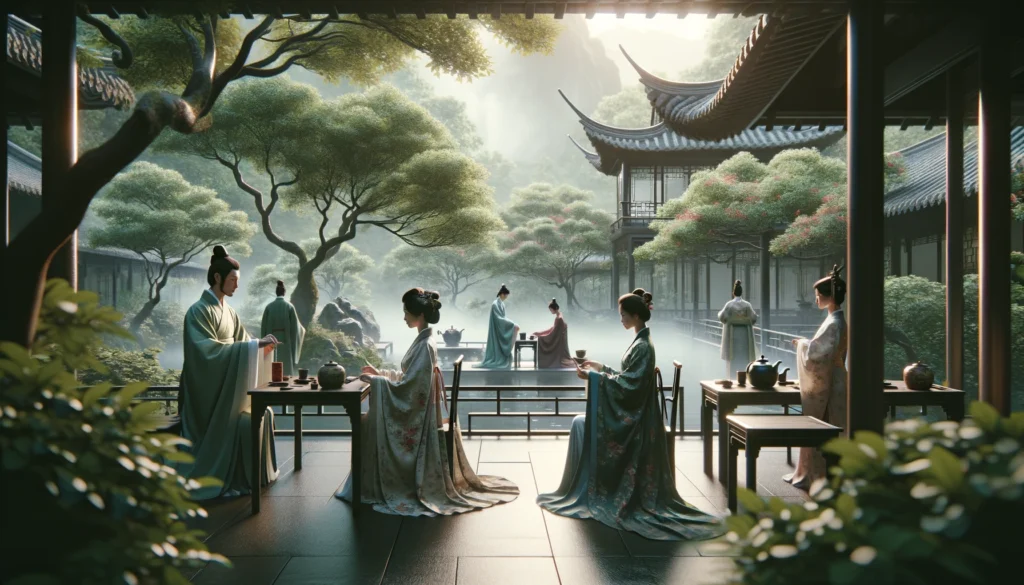
The evolution of clothing styles in ancient China is a narrative of form, function, and philosophy, weaving together elements of tradition, symbolism, and societal norms into its fabric. Let’s explore the cornerstone garments that have come to define Chinese cultural attire through the ages.
Discuss the basic forms of traditional Chinese clothing, such as top-bottom clothes and one-piece clothes.
- Hanfu: The archetype of traditional Chinese dress, Hanfu encompasses a variety of styles, from the cross-collared robe to layered garments that demonstrate the wearer’s social status. Its evolution reflects changes in aesthetics and societal values over millennia, embodying the harmony between humans and nature.
- Cheongsam (Qipao): A symbol of modern Chinese fashion, the Qipao emerged as a one-piece dress that snugly fits the body, showcasing the elegance and grace of the wearer. Its simplicity and versatility have allowed it to transcend time, becoming a global icon of Chinese culture.
- Influence of Religious and Philosophical Ideals: Both Hanfu and Qipao are deeply rooted in Confucian, Taoist, and Buddhist philosophies, emphasizing modesty, harmony, and balance. These garments are not just clothes but manifestations of ancient wisdom and ideals.
Explain the influence of the five elements on the color system in traditional Chinese clothing.
- The concept of the five elements (wood, fire, earth, metal, and water) plays a pivotal role in determining the color palette of traditional Chinese attire. Each element is associated with specific colors, imbuing garments with deeper meanings and intentions. For example, black (water) represents wisdom and depth, while red (fire) symbolizes good fortune and joy. This color system underscores the cultural significance of clothing beyond mere aesthetic appeal, reflecting the wearer’s aspirations and societal values.
Describe the differences between men’s and women’s clothing, including ornaments and styles.
- Gender Distinctions: Ancient Chinese fashion clearly delineated between male and female attire, with men’s clothing emphasizing strength, dignity, and a more restrained aesthetic, while women’s clothing highlighted grace, beauty, and delicacy through intricate embroideries and fluid silhouettes.
- Ornaments and Styles: Accessories and ornaments further accentuated these distinctions. Men might adorn themselves with jade belts or scholarly hats, symbols of their status and intellect, whereas women could wear elaborate hairpins and jewelry, each piece a testament to their femininity and social standing.
Through the lens of clothing styles, we gain insights into the complexities of ancient Chinese society, where every garment tells a story of identity, philosophy, and the eternal quest for beauty and harmony.
Key Figures in Chinese Fashion
The annals of Chinese fashion are adorned with figures whose contributions have not only shaped the course of attire through the ages but have also left an indelible mark on the cultural fabric of China. Let’s pay homage to these pioneers and their timeless legacies.
Introduce influential figures in Chinese fashion history, such as Hanfu’s originator, Huangdi’s consort, and notable designers.
- Huangdi’s Consort, Leizu: Often celebrated as the progenitor of sericulture, Leizu’s discovery of silk has woven a thread of luxury and innovation through Chinese fashion. Her contribution extends beyond material to the very ethos of Chinese attire, emphasizing the importance of elegance and natural beauty.
- Bian He: While not a designer, his tale of discerning the true value of a jade stone parallels the discernment needed in fashion to recognize and cherish true beauty, an ethos that underpins the aesthetics of Chinese clothing.
- Ma Ke: A contemporary designer who bridges the traditional with the modern, Ma Ke’s work emphasizes sustainability and a return to the roots, reflecting on the deeper meanings and connections between clothing and culture.
Explain how these figures shaped the evolution of Chinese fashion.
- Stories of Innovation: Each of these individuals brought forth innovation in their time. Leizu, with her silk, transformed the material possibilities of fashion, imbuing it with a sense of luxury and refinement that became synonymous with Chinese attire.
- Influence: Their influences extend beyond the mere aesthetics of clothing. For instance, the story of Bian He and the jade teaches the value of foresight and appreciation for intrinsic beauty, qualities that are reflected in the meticulous designs and cultural depth of Chinese fashion.
- Legacy: The legacies of these figures are not just in the garments or materials they introduced but in the philosophies they embedded within the fabric of Chinese culture. Ma Ke’s work, focusing on environmental consciousness and cultural depth, forges a path for the future of fashion that honors its past while innovating sustainably.
Through their contributions, these key figures have not only shaped the sartorial landscape of China but have also ensured that Chinese fashion remains a vibrant, evolving testament to the nation’s rich history, culture, and philosophical insights.
Hanfu, Qipao, Tang Suit, and Zhongshan Suit
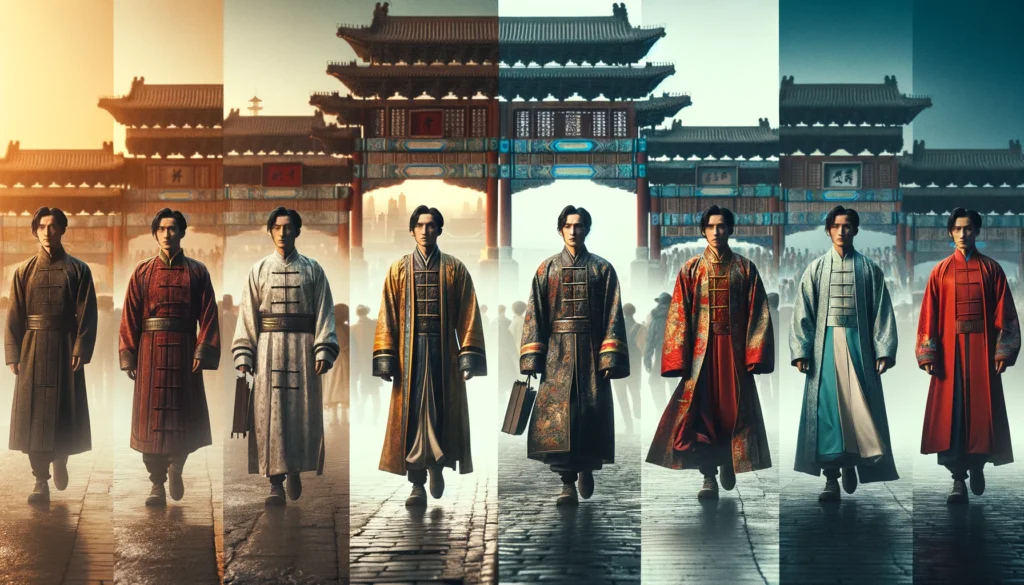
The fabric of Chinese history is richly embroidered with various clothing styles, each telling a unique story of its era. Among these, the Hanfu, Qipao, Tang Suit, and Zhongshan Suit stand out as iconic symbols of Chinese sartorial elegance, reflecting the cultural, social, and political narratives of their times.
Provide detailed descriptions of these iconic traditional Chinese clothing styles.
- Hanfu: The Hanfu, with its origins in the Han Dynasty, is characterized by its cross-collar, wide sleeves, and flowing robes. This attire is a testament to the value of harmony and balance, embodying the Confucian principle of ritual and order. It’s an ensemble that consists of several layers and pieces, each serving a specific purpose and occasion, reflecting the wearer’s social status and the ceremonial significance of the event.
- Qipao (Cheongsam): Evolving from the loose-fitting garments of the Qing Dynasty, the Qipao emerged in the 20th century as a figure-hugging dress that epitomized femininity and grace. With its high collar, slits on the side, and intricate designs, the Qipao represents a blend of traditional Chinese aesthetics with modern sensibilities, marking the social progress and liberation of Chinese women.
- Tang Suit: Despite its name, the Tang Suit is not directly descended from the Tang Dynasty but rather inspired by the jackets worn over the Hanfu. It gained popularity in the West as the “Mandarin Gown.” This style is known for its straight collar and knotted buttons, symbolizing the fusion of Chinese tradition with foreign influences, particularly during the Qing Dynasty when such adaptations became prevalent.
- Zhongshan Suit (Mao Suit): Named after Sun Yat-sen (Sun Zhongshan), the Zhongshan Suit is a modern Chinese suit that combines traditional Chinese simplicity with Western-style clothing. It features a turned-down collar, four pockets, and five center-front buttons, representing the unity of the Chinese people and the revolutionary spirit of modern China.
Explain the historical context and cultural significance of each style.
- Hanfu: This garment harks back to a time when social hierarchy and harmony were deeply ingrained in the fabric of society. Its design and structure are reflective of the Confucian ideals of order, hierarchy, and respect for tradition.
- Qipao: The Qipao’s evolution mirrors the social changes and the increasing empowerment of women in Chinese society. It became a symbol of modernity and a break from traditional restrictions, embodying the new female identity.
- Tang Suit: The Tang Suit’s adoption and adaptation from foreign jackets signify China’s openness to external influences and the blending of cultures, a hallmark of the cosmopolitan Tang Dynasty that it erroneously names, demonstrating China’s long history of cultural exchange.
- Zhongshan Suit: As a representation of modernity and nationalism, the Zhongshan Suit symbolizes the break from feudal traditions and the embrace of a new, unified China, reflecting the country’s journey towards modernization and national identity.
Include visuals of these clothing styles.
- Visuals: To truly appreciate the beauty and intricacy of these garments, one must see their vibrant patterns, elegant designs, and the subtle yet significant differences that distinguish each style. Through photographs and artistic representations, we can observe the evolution of Chinese fashion and its deep-rooted connections to the country’s rich heritage.
By exploring these iconic garments, we not only uncover the aesthetic beauty of Chinese traditional clothing but also delve into the profound cultural narratives and historical contexts that they embody, offering a window into the soul of China’s past and present.
Materials and Techniques
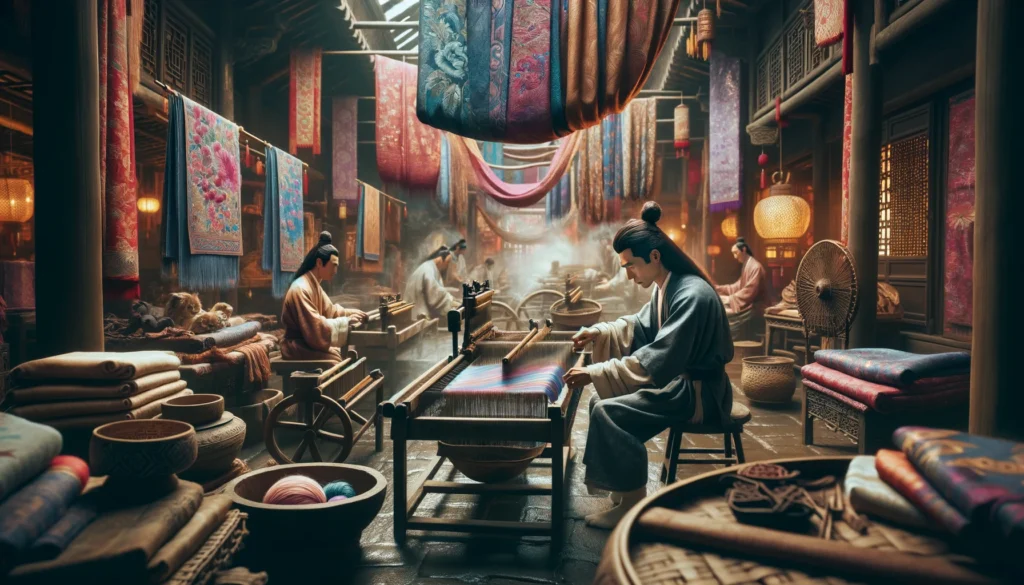
The legacy of ancient Chinese fashion is not only found in its styles and figures but also in the materials and techniques that have been refined over millennia. These elements are a testament to China’s innovative spirit and its significant role in global cultural exchange, particularly through the Silk Road. Let’s unravel the threads of history to explore the materials and artistry that have shaped Chinese clothing.
Discuss the materials used in ancient Chinese clothing, such as silk, linen, and cotton.
- Silk: More than just a material, silk represents China’s contribution to the world’s luxury and is central to the development of the Silk Road. This delicate yet strong fabric was a symbol of status and wealth, reserved for the elite and for offerings to the gods. Its production, kept secret for centuries, showcases the ingenuity and sophistication of ancient Chinese society.
- Linen and Cotton: While silk dominated the luxury market, linen and cotton were the staples of the common folk. These materials, breathable and easier to produce, were essential to everyday life and work. They allowed for a diversity of clothing suited to China’s varied climates and social classes.
Explain the techniques used in ancient Chinese clothing, such as weaving, dyeing, and embroidery.
- Weaving: Ancient Chinese weaving techniques were unparalleled in their complexity and beauty. The use of looms to create intricate patterns and textures in fabrics demonstrates an early understanding of geometry and aesthetics, making each piece a work of art.
- Dyeing: The process of dyeing was not just about color but also imbued the fabric with meaning. Colors were chosen for their symbolism and were often used to indicate status, season, or philosophical ideals. The development of plant-based dyes allowed for a vibrant palette that could be adjusted according to the natural world and cultural significance.
- Embroidery: Embroidery in ancient China was a revered skill, reflecting the wearer’s status and the embroiderer’s craftsmanship. This technique added depth and narrative to garments, with motifs that ranged from mythical creatures to symbolic flora and fauna, each stitch a testament to the patience and creativity of its maker.
Through these materials and techniques, ancient Chinese clothing transcends its functional purpose, becoming a medium through which the tapestry of China’s history, culture, and technological advancement is woven. The legacy of these textiles continues to influence fashion, both in China and globally, reminding us of the enduring power of cultural expression through dress.
Social and Cultural Context
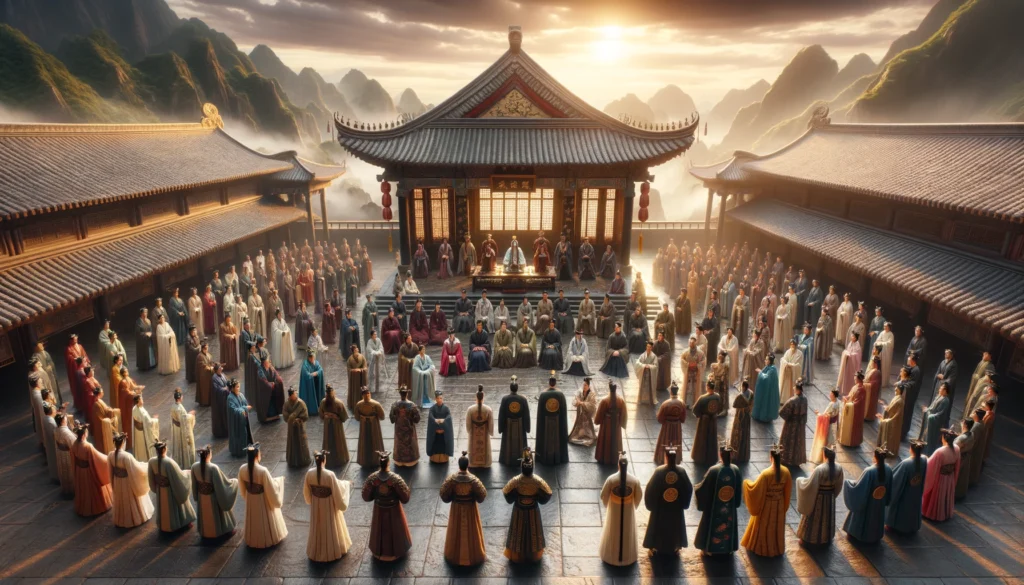
In the tapestry of ancient Chinese society, clothing was not merely a protective layer against the elements but a rich lexicon of symbols that communicated the wearer’s social status, profession, and moral standing. Each fold, color, and pattern was imbued with meaning, creating a visual dialogue that spoke volumes about the individual and their place within the intricate social hierarchy.
Explain how clothing styles reflected social status, customs, and beliefs.
- Dress Codes and Social Hierarchy: The ancient Chinese society was highly stratified, and this hierarchy was visibly mirrored in its dress codes. Emperors adorned dragon robes, symbols of supreme power and authority, while officials wore robes with mandarin squares that depicted birds or animals according to rank. Commoners were restricted by sumptuary laws, limiting the richness and quality of fabrics and colors they could wear, thus ensuring that clothing was a clear marker of social divisions.
- Customs and Beliefs: Clothing also served as a canvas to express cultural values and beliefs. The use of specific colors during festivals or life events (red for weddings, white for mourning) underscored the deep intertwining of attire with tradition and ritual. The preference for loose garments reflected the Confucian ideal of modesty and restraint, while the meticulous attention to etiquette in dressing echoed Taoist principles of harmony and balance.
Discuss the role of clothing in ancient Chinese society, such as the importance of proper decorum and the rules of wearing.
- Philosophical and Ethical Considerations: In Confucian thought, clothing was not just a matter of personal taste but a manifestation of one’s virtue and respect for social order. The concept of “yi,” which can be translated as both “clothing” and “righteousness,” highlights the ethical dimensions of dress. Proper attire was seen as a reflection of one’s inner moral state and a form of non-verbal communication that conveyed respect for oneself and others.
- Rules of Wearing: The ancient Chinese were governed by a complex set of rules concerning dress, which dictated not only what to wear for different occasions but also how to wear it. For instance, the way in which a sash was tied or the length of a garment could carry implications about the wearer’s age, marital status, or mourning state. These rules reinforced social cohesion, ensuring that individual presentation aligned with collective values and norms.
Through its clothing, ancient Chinese society wove a dense fabric of social codes, ethical values, and philosophical ideals, creating a sartorial system that was both a mirror of its time and a canvas for expressing the deeper currents of cultural identity and continuity.
Influences and Legacy
The story of Chinese fashion is not one of isolation but of vibrant exchange and adaptation, a testament to China’s long history of interaction with the world. This narrative of exchange has enriched the fabric of Chinese culture, weaving foreign threads into its own, creating a tapestry that is both uniquely Chinese and universally human.
Explain how foreign influences shaped Chinese fashion history.

- Interactions with Neighboring Cultures: The Silk Road, a network of trade routes connecting China to the Middle East, Europe, and beyond, was not just a conduit for goods but also for ideas and cultural exchange. Through it, fabrics, dyes, and styles flowed into China, influencing its fashion. The Tang Dynasty, in particular, saw a flourishing of such exchanges, adopting and adapting foreign styles into its own, such as the wider use of trousers, a departure from the traditional Hanfu.
- Integration of Foreign Elements: Over the centuries, China absorbed elements from various cultures, including the Mongolian influence during the Yuan Dynasty and Manchurian styles in the Qing Dynasty. The Qipao, for instance, evolved from a loose-fitting garment into the form-fitting dress known today, reflecting both the influence of Western fashion and the modernization of Chinese society.
Discuss the legacy of ancient Chinese fashion, including its revival and modern adaptations.
- Resurgence of Traditional Styles: In recent years, there has been a growing movement within China to revive traditional clothing styles, such as the Hanfu. This movement is not merely about fashion but is tied to a larger cultural renaissance seeking to reconnect with and celebrate Chinese heritage. Hanfu clubs, social media platforms, and cultural festivals have all contributed to this resurgence, making traditional attire a common sight at weddings, festivals, and public holidays.
- Modern Adaptations: Contemporary Chinese designers are drawing inspiration from their rich sartorial history, blending ancient techniques with modern aesthetics. This fusion has led to innovative designs that are gaining popularity on international runways, showcasing the versatility and enduring appeal of Chinese fashion. Brands and designers are incorporating traditional motifs, fabrics, and craftsmanship into modern clothing, creating pieces that speak to a global audience while deeply rooted in Chinese culture.
The legacy of ancient Chinese fashion, with its deep historical roots and vibrant exchange with foreign cultures, continues to influence not only the way people dress but also how they connect with their cultural identity in a rapidly globalizing world. This enduring legacy ensures that Chinese fashion remains a dynamic and evolving expression of cultural pride and artistic innovation.
Conclusion
The exploration of Chinese ancient fashion is not merely a journey through the evolution of clothing but a profound insight into the cultural, social, and philosophical tapestry that has shaped China and its interaction with the world. This rich heritage offers a unique lens through which we can understand the complexities of human expression, identity, and cultural exchange.
Understanding Chinese ancient fashion within the broader context of world history and cultural studies illuminates the interconnectedness of cultures and the ways in which societies influence and inspire one another. It highlights the importance of preserving and celebrating cultural heritage, while also recognizing the dynamic nature of cultural expression as it evolves and adapts over time.
The legacy of Chinese ancient fashion, with its intricate designs, symbolic colors, and innovative techniques, continues to influence modern fashion, bridging the gap between past and present, tradition and innovation. It serves as a reminder of the enduring power of clothing as a form of cultural expression, capable of conveying complex social and philosophical ideals, and connecting individuals across time and space.
In a world that is increasingly globalized yet yearning for individuality and cultural authenticity, the study of Chinese ancient fashion offers valuable lessons in diversity, sustainability, and creativity. It challenges us to look beyond the surface of clothing to the rich stories, traditions, and meanings that they embody, fostering a deeper appreciation for the diversity of human culture and the shared threads that weave us together.
As we continue to explore and celebrate the vast tapestry of world fashion, let us remember the contributions of Chinese ancient fashion, not just as historical artifacts, but as living expressions of a vibrant cultural legacy that continues to inspire and resonate in the global fashion narrative.
FAQ
Delving into the intricacies of Chinese ancient fashion uncovers a world rich with history, symbolism, and artistry. Below are answers to some frequently asked questions that shed light on this fascinating subject, offering insights into specific garments, cultural influences, and more.
- What is the significance of the Hanfu?
- Hanfu is more than just a traditional Chinese garment; it symbolizes China’s cultural heritage and the Confucian ideals of harmony and propriety. Its design reflects the social hierarchy and philosophical concepts of ancient China, making it a key piece in understanding Chinese history and culture.
- How did the Silk Road influence Chinese fashion?
- The Silk Road was instrumental in facilitating cultural exchange between China and the rest of the world. It introduced new materials, techniques, and styles into Chinese fashion, enriching it with diverse influences that shaped its evolution over centuries.
- What distinguishes the Qipao from other traditional Chinese garments?
- The Qipao, or Cheongsam, is known for its form-fitting silhouette and distinctive style that emerged in the 20th century. It represents a blend of traditional Chinese aesthetics and modern sensibilities, reflecting the social changes and the increasing empowerment of women in Chinese society.
- Can men wear Hanfu, and if so, how does it differ from women’s Hanfu?
- Yes, men can and do wear Hanfu. Men’s Hanfu typically features a cross-collar, wide sleeves, and a sash to cinch at the waist, similar to women’s but with less emphasis on intricate embroidery and more on simplicity and elegance, reflecting the Confucian ideal of modesty and restraint.
- What role did color play in ancient Chinese fashion?
- Color played a crucial role in ancient Chinese fashion, with each hue carrying specific symbolic meanings. Colors were chosen based on the wearer’s social status, the season, or the occasion, reflecting the deep connection between clothing and cultural values.
- How are traditional Chinese clothing styles being adapted in modern fashion?
- Traditional Chinese clothing styles are experiencing a revival and adaptation in modern fashion. Designers are incorporating traditional motifs, fabrics, and silhouettes into contemporary designs, creating a fusion that honors the past while embracing current trends. This includes using digital printing techniques to replicate traditional patterns on modern fabrics and reimagining traditional garments like the Hanfu and Qipao in new contexts.
- What is the future of Chinese ancient fashion in the global fashion industry?
- The future of Chinese ancient fashion in the global fashion industry looks promising as it continues to inspire designers around the world. Its rich history, unique aesthetics, and deep cultural roots offer endless possibilities for creative exploration and innovation, positioning it as a significant influence on global fashion trends.
